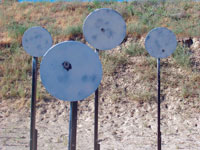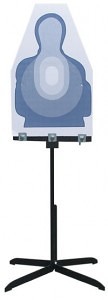There seems to be an ongoing industry-wide debate about which targets are best—paper or steel. While neither one will ever be crowned the ultimate victor, Action Target’s Steel Target Resource Guide gives meaningful insight to outline the strengths and weaknesses of each target type.
Paper
 Shooting on paper is a great way to sight-in rifles and score trainings, and is great for qualifications held by law enforcement agencies. Paper allows a shooter to see where shots land, illustrating how tight groups are. The NRA and other leading organizations use a lot of paper targets precisely for this reason. Another benefit of paper targets is that they provide a bigger variety of shapes, sizes, pictures, and scenarios (there are even a lot of zombie targets out now to add an extra element of fun to training). Each organization has its own types of score zones, stages, and qualification targets, so the wide variety of paper targets allows for greater flexibility between events. Many competitions use paper targets because of this flexibility.
Shooting on paper is a great way to sight-in rifles and score trainings, and is great for qualifications held by law enforcement agencies. Paper allows a shooter to see where shots land, illustrating how tight groups are. The NRA and other leading organizations use a lot of paper targets precisely for this reason. Another benefit of paper targets is that they provide a bigger variety of shapes, sizes, pictures, and scenarios (there are even a lot of zombie targets out now to add an extra element of fun to training). Each organization has its own types of score zones, stages, and qualification targets, so the wide variety of paper targets allows for greater flexibility between events. Many competitions use paper targets because of this flexibility.
Steel
One of the greatest benefits of using steel targets is the instant feedback they provide. Shooters can usually see and hear when they’ve hit a steel target and this is something that cannot be done when using a paper target. Whether the range is training civilians or law enforcement officials, steel targets help shooters know whether their intended target was hit or not. Hearing and reacting to the sound of a shot hitting a target helps program muscle memory, which reinforces positive behavior.  Just like in all athletic training, the body subconsciously remembers how to repeat or orchestrate all the different variables required for a successful movement, or in this case, shot. The ability that steel targets offer in regards to instantaneous feedback can actually enhance training, speed, and accuracy. This is especially important for tactical shooting scenarios with movement, such as moving plates and targets. Having multiple senses invoked during this training process conditions the shooter to become a more powerful and effective shooter.
Just like in all athletic training, the body subconsciously remembers how to repeat or orchestrate all the different variables required for a successful movement, or in this case, shot. The ability that steel targets offer in regards to instantaneous feedback can actually enhance training, speed, and accuracy. This is especially important for tactical shooting scenarios with movement, such as moving plates and targets. Having multiple senses invoked during this training process conditions the shooter to become a more powerful and effective shooter.
Another benefit of reactive steel targets is the pure entertainment factor. It may seem frivolous at first, but it can provide an enormous benefit to a training program. The fall, spin, bounce, and dodge of a target all lead to a fun and enjoyable experience for shooters of all skill levels. This will eventually lead to an increase in range use and therefore, an increase in profitability for the range.
So, should you shoot on paper or steel targets? In short, it depends on the purpose of the shooting exercise. As already discussed, if the purpose is for scoring, a paper target is best. However, if the shooter wants immediate feedback and would like to train on a more tactical level, steel targets are recommended. For more information on making the best decision, download Action Target’s Steel Resource Guide.







 Many people have survived getting shot multiple times. The cliché “one shot, one kill” should be discarded from the war-fighter lexicon. This is especially the case for gun rounds, but also true with most every caliber of long gun used for close-quarters engagements.
Many people have survived getting shot multiple times. The cliché “one shot, one kill” should be discarded from the war-fighter lexicon. This is especially the case for gun rounds, but also true with most every caliber of long gun used for close-quarters engagements. One of the most enjoyable drills for me personally is a six-shot rhythm drill with my handgun. I use paper targets on my
One of the most enjoyable drills for me personally is a six-shot rhythm drill with my handgun. I use paper targets on my